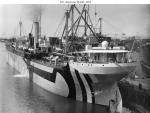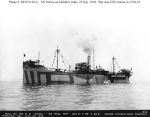NavSource Online:
Identification Numbered Vessel Photo Archive
Aniwa (ID 3146)
Love - Mike - Fox - Tare
Specifications:
| Click on thumbnail for full size image |
Size | Image Description | Source | |
|---|---|---|---|---|
 |
132k | Preparing for her trial trip on 24 July 1918 at the yard of her builder, the Moore Shipbuilding Co., Oakland, California National Archives photo from Shipscribe.com |
Robert Hurst | |
 |
71k | Underway during her builder's trials, 25 July 1918. Note her "dazzle" camouflage scheme U.S. Navy photos NH 65140-A and NH 65141 |
Naval Historical Center | |
 |
41k | |||
| Commanding Officers | ||
| 01 | LCDR Foster Ryer, USNRF | 26 July 1918 |
| 02 | LCDR Peter Donnley, USNRF | 1919 |
|
|
Aniwa
A village in Shawano County, Wisconsin; a corruption of the Chippewa Indian prefix "aniwi" which signifies superiority
Shifting to the Mare Island Navy Yard Vallejo, Calif., on the 27th to take on stores and embark the balance of her crew, Aniwa moved to Port Costa on the 31st and loaded a cargo of flour. Underway for the east coast of the United States on 7 August, Aniwa transited the Panama Canal on the 23d and after clearing Cristobal, Panama, early on the 24th-shaped course for New York. She reached Brooklyn, on the afternoon of 4 September.
Shortly after midday on the 15th, Aniwa headed out to sea in a convoy bound, ultimately, for the North Russian port of Archangel. Earlier in the year, Ambassador David R. Francis had urged the sending of shiploads of foodstuffs to Archangel for a three-fold purpose: (1) to feed the local Russian population whose flow of provisions had been interrupted by the Czech Legion's occupation of the Trans-Siberian Railway; (2) to provide for the Allied representatives in the city of Vologda should they retire northward; and (3) to create a favorable image of the United States.
Aniwa arrived off the mouth of the Dvina River on 11 October and ascended that waterway the following day and at 1745 made fast alongside the British merchantman SS Grofe Castle which in turn was moored to a wharf. She immediately posted watches bow and stern to protect the ship and her cargo. Two days later four soldiers-a corporal and three privates--reported to the ship to serve as an
"armed guard."
An outbreak of influenza in the seaport curtailed liberty for the crew during certain periods of the ship's stay in Archangel. It even struck the ship's hospital corpsman, who had to be sent ashore for treatment in the American Red Cross hospital. To fill the gap created by his illness, the ships' doctors of West Gambo (Id. No. 3220) and Olympia (Cruiser No. 6) visited Aniwa and ministered to her sick.
Unloading operations proceeded nearly without incident. On the afternoon of 23 October, two Russian stevedores, obviously feeling the shortage of foodstuffs ashore, were caught trying to leave the ship with small quantities of Aniwa's cargo of flour.
Then, on 5 November, a sling broke dropping a bale of hemp on a Russian stevedore. Fortunately, the man was not badly hurt and was soon on his way to a Russian hospital for treatment.
Underway for the United States on the morning of 10 November with a small number of passengers embarked, Aniwa sailed in ballast and reached Brooklyn, on 8 December. Shifting to Bush Docks, Brooklyn, soon thereafter, she loaded 6,905 tons of general cargo and underwent a few minor repairs before beginning her next voyage, this time under the auspices of the Naval Overseas
Transportation Service.
Four days after Christmas of 1918, shortly after midday, Aniwa cleared the port of New York on her first post-armistice voyage, bound for Gibraltar. As the days wore on, the weather remained fairly rough, with the ship rolling easily in the long swells, and she took water forward and aft; a leak in the after storeroom occupied the attention of at least one man for nearly an entire day on 7 January 1919. Soon thereafter, problems with her condenser and boilers forced her to put into the Azores on the 10th for voyage repairs.
Underway again on 28 January, Aniwa reached Gibraltar on 4 February and tarried there for a short while before resuming her voyage to Genoa, Italy, where she arrived on the morning of 11 February.
Inept cargo handling during unloading operations caused much damage to the shipment of foodstuffs that the ship had carried from New York. Finally, after having discharged all that she had brought, by- early March, Aniwa took on ammunition from the Navy tugs Nahant and Penobscot for transportation back to the United States, and then loaded ballast for the return trip. She departed from that Italian port on the morning of St. Patrick's Day.
After touching briefly at Gibraltar on 23 and 24 March to pick up passengers, Aniwa continued her homeward-bound voyage, ultimately arriving off Tompkinsville, Staten Island, on 15 April. There, she unloaded the ammunition and soon moved to the pier at East 19th Street, New York City. She was decommissioned there on 21 April 1919, and her name was struck from the Navy list that same day.
Turned over to the USSB for operation, Aniwa continued carrying cargo, this time under civilian auspices. Her travels for the remainder of 1919 took her to Mobile Ala.; Liverpool, England; and Newport News, Va. Laid up in 1923, Aniwa remained inactive for the next six years or so, until being "abandoned" due to age and deterioration during the fiscal year 1930.
| Back To The Main Photo Index | Back to the Identification Numbered Vessel (ID) Photo Index |
| Comments, Suggestions, E-mail Webmaster |
|
This page created by Joseph M. Radigan and maintained by David Wright |